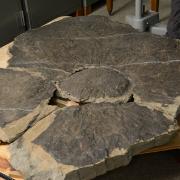Did you know that fossils of the Earth's oldest trees are part of the State Museum's collections? In the late 19th century, scientists uncovered evidence of the world's oldest known forest in Gilboa, NY (Schoharie County). Since then, the Museum has collected a variety of specimens from the site, including tree stumps and other forest plants.
The Gilboa trees, called Eospermatopteris, date back to the Devonian Period (roughly 380 - 385 million years ago). Eospermatopteris was one of the first plants on Earth to have a tree-like form. It resembled a fern - there was no wood on the tree - and grew to be about 30 feet tall.
One Gilboa tree stump specimen includes the underside of a stump with impressions of the roots mixed together with tiny plants called lycopods. It was on display in the mid-1900s when the State Museum was located in the State Education Building on Washington Avenue. When the Museum moved to its current location in the Cultural Education Center on Madison Avenue, the specimen had to be broken into pieces to move it to its new space.
Earlier this year, Frank Mannolini, a collections technician at the Museum, reassembled the specimen. Conservation techniques and technology has improved significantly since the 1970s, and researchers from the United Kingdom and SUNY Binghamton re-examined the specimen again and learned new information that will be published in an upcoming paper on the tree root systems in the Devonian Period.
State paleontologist Lisa Amati says that this demonstrates the importance of keeping collections. "Technology is constantly improving and we're able to use new technology today that was not available half a century ago," she said. "The original discovery of the Gilboa tree forest was incredibly significant and, thanks to new technology, we continue to learn more from the Gilboa specimens today."




